新疆大学:《国际法》课程授课教案(英文版)
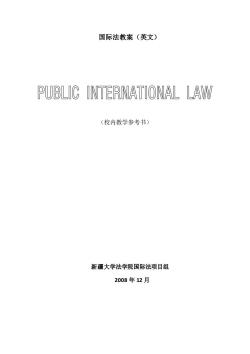
国际法教案(英文) PUBLIC INTERNATIONAL LAW (校内教学参考书) 新疆大学法学院国际法项目组 2008年12月
国际法教案(英文) (校内教学参考书) 新疆大学法学院国际法项目组 2008 年 12 月

说明 本教材仅在新疆大学法学院范围内,作为高年级本科生的双语教 学试验参考书使用,特此说明。 编者 2008年12月
说 明 本教材仅在新疆大学法学院范围内,作为高年级本科生的双语教 学试验参考书使用,特此说明。 编 者 2008 年 12 月
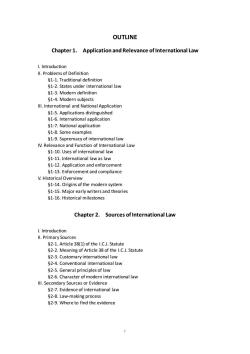
OUTLINE Chapter 1.Application and Relevance of International Law L Introduction Il.Problems of definition .Traditional definitio s1-2. tes und r international law 51-3.Modern definition 61-4.Modern subiects Ill.International and National Application $1-7.National application 51-8.Some examples 51-9.Supremacy of international law IV.Relevance and Function of International Law 51-10.Uses of in national law $1-11.International law as law 51-12.Application and enforcement $1-13.Enforcement and compliance V.Historical Overview $1-14.Origins of the modern syste em 15.Major theories 51-16.Historical milestones Chapter 2.Sources of International Law I.Introduction Il.Primary Sources 52-1.Article38(1)of the I.C.J.Statute 52-2.Meaning of Article 38 of the I.C.J.Statute $2-3.Customaryinte ational law $2-4.Conventional international law 52-5.General principles of law $2-6.Character of modern international law Ill.Secondary Sources or Evidence 52-7.Evidence of international law S2-8.Law-making proc 52-9.Where to find the evidence
i OUTLINE Chapter 1. Application and Relevance of International Law I. Introduction II. Problems of Definition §1-1. Traditional definition §1-2. States under international law §1-3. Modern definition §1-4. Modern subjects III. International and National Application §1-5. Applications distinguished §1-6. International application §1-7. National application §1-8. Some examples §1-9. Supremacy of international law IV. Relevance and Function of International Law §1-10. Uses of international law §1-11. International law as law §1-12. Application and enforcement §1-13. Enforcement and compliance V. Historical Overview §1-14. Origins of the modern system §1-15. Major early writers and theories §1-16. Historical milestones Chapter 2. Sources of International Law I. Introduction II. Primary Sources §2-1. Article 38(1) of the I.C.J. Statute §2-2. Meaning of Article 38 of the I.C.J. Statute §2-3. Customary international law §2-4. Conventional international law §2-5. General principles of law §2-6. Character of modern international law III. Secondary Sources or Evidence §2-7. Evidence of international law §2-8. Law-making process §2-9. Where to find the evidence

Chapter 3.States and International Organizations I.Introduction Il.States $3-1.Recognition doctrine generally 53.2Re nition of states 53-4.Recognition of governments 53-5.Recognition in U.S.practice lL International organizations generally $3-6.Nature of international organizations 3-7.peratin 3-8.Historical backgroun IV.United Nations 53-9.U.N.Charter $3-10.Nature and function 63-11 Inter national constitutional supremacy 53-12.U.N.0rgan 53-13.Voting procedures $3-14.Binding character of U.N.resolutions 53-15.Law-making and legislative activities V.U.N.SpecializedAgencies $3-16.Definitior 53-17.Organizations having specialized agency status 53-18.Member states V.U.N.Specialized Agencies-Continued 53-19.Legislative activities VI.Re onal Orga 3-20.General description 53-21.Basic characteristics $3-22.Major regional organizations 53-23.Membership reguirements 53-24 Institutional str ucture $3-25.Functio s and achie ements VII.Supranational Organizations 53-26.Meaning of supra-nationality 53-27.Supra-nationality and the European Union S3-28.Mandate of the European Union 63-29.ECinstitut al str 53-30.EClaw-making 53-31.EC law and national law VIll.Non-State Actors 53-32.Non-governmental organizations
ii Chapter 3. States and International Organizations I. Introduction II. States §3-1. Recognition doctrine generally §3-2. Recognition of states §3-3. Dissolution of the USSR §3-4. Recognition of governments §3-5. Recognition in U.S. practice III. International Organizations Generally §3-6. Nature of international organizations §3-7. Operational legal issues §3-8. Historical background IV. United Nations §3-9. U.N. Charter §3-10. Nature and function §3-11. International constitutional supremacy §3-12. U.N. organs §3-13. Voting procedures §3-14. Binding character of U.N. resolutions §3-15. Law-making and legislative activities V. U.N. Specialized Agencies §3-16. Definition §3-17. Organizations having specialized agency status §3-18. Member states V. U.N. Specialized Agencies-Continued §3-19. Legislative activities VI. Regional Organizations §3-20. General description §3-21. Basic characteristics §3-22. Major regional organizations §3-23. Membership requirements §3-24. Institutional structure §3-25. Functions and achievements VII. Supranational Organizations §3-26. Meaning of supra-nationality §3-27. Supra-nationality and the European Union §3-28. Mandate of the European Union §3-29. EC institutional structure §3-30. EC law-making §3-31. EC law and national law VIII. Non-State Actors §3-32. Non-governmental organizations
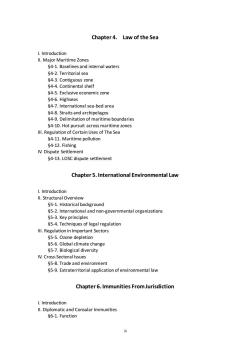
Chapter4.Law of the Sea I.Introduction Il.Major Maritime Zones $4-1.Baselines and internal waters $4-2.Territorial sea $4-5.Exclusive economic zone 54-6.Highseas 54-7.International sea-bed area 54-9.Del nof maritime boundarie 54-10.Hot pursuit across maritime zones Ill.Regulation of Certain Uses of The Sea $4-11.Maritime pollution 54-12.Fishing IV.Dispute Settle ent $4-13.LOSC dispute settlement Chapter 5.International Environmental Law ll.Structural Overview 55-1.Historical background 55-2.International and non-governmental organizations $5-3.Key principles $5-4.Techniques of legal regulation Ill.Regulation in Important Sectors 55-5.Ozone depletion 55-6.Global climate change 55-7.Biological diversity IV.Cross-Sec ral Issues $5-8.Trade and environment 55-9.Extraterritorial application of environmental law Chapter 6.Immunities FromJurisdiction I.Introduction ll.Diplomatic and Consular Immunities $6-1.Function
iii Chapter 4. Law of the Sea I. Introduction II. Major Maritime Zones §4-1. Baselines and internal waters §4-2. Territorial sea §4-3. Contiguous zone §4-4. Continental shelf §4-5. Exclusive economic zone §4-6. Highseas §4-7. International sea-bed area §4-8. Straits and archipelagos §4-9. Delimitation of maritime boundaries §4-10. Hot pursuit across maritime zones III. Regulation of Certain Uses of The Sea §4-11. Maritime pollution §4-12. Fishing IV. Dispute Settlement §4-13. LOSC dispute settlement Chapter 5. International Environmental Law I. Introduction II. Structural Overview §5-1. Historical background §5-2. International and non-governmental organizations §5-3. Key principles §5-4. Techniques of legal regulation III. Regulation in Important Sectors §5-5. Ozone depletion §5-6. Global climate change §5-7. Biological diversity IV. Cross-Sectoral Issues §5-8. Trade and environment §5-9. Extraterritorial application of environmental law Chapter 6. Immunities From Jurisdiction I. Introduction II. Diplomatic and Consular Immunities §6-1. Function
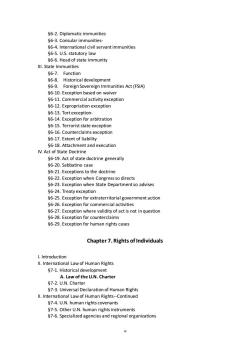
56-2.Diplomatic immunities 56-4.1 $6-5.U.S.statutory law 56-6.Head of state immunity Ill.State Immunities $6-7.Function 6g Historical development 56-9. Foreign Sovereign Immunities Act(FSIA) 56-10.Exception based on waiver $6-11.Commercial activity exception $6-12.Expropriation exception 56-13.Tortexe or arbitratior $6-15.Terrorist state exception 56-16.Counterclaims exception 56-17.Extent of liability execution ctrine 56-19.Act of state doctrine generally 56-20.Sabbatino case 56-21.Exceptions to the doctrine $6-23.Exception when State 56-24.Treaty exception 56-25.Exception for extraterritorial government action $6-26.Exception for commercial activities $6-27.Exception where validity of act is not in question ception for nterc S6-29.Exception for human rights cases Chapter 7.Rights of Individuals ll.International Law of Human Rights 57-1.Historical development A.Law ofthe U.N.Charter 67-2.U.N.Charter 7-3.Universal De claration of Human Right ll.International Law of Human Rights-Continue $7-4.U.N.human rights covenants $7-5.Other U.N.human rights instruments 57-6.Specialized agencies and regional organizations
iv §6-2. Diplomatic immunities §6-3. Consular immunities- §6-4. International civil servant immunities §6-5. U.S. statutory law §6-6. Head of state immunity III. State Immunities §6-7. Function §6-8. Historical development §6-9. Foreign Sovereign Immunities Act (FSIA) §6-10. Exception based on waiver §6-11. Commercial activity exception §6-12. Expropriation exception §6-13. Tort exception- §6-14. Exception for arbitration §6-15. Terrorist state exception §6-16. Counterclaims exception §6-17. Extent of liability §6-18. Attachment and execution IV. Act of State Doctrine §6-19. Act of state doctrine generally §6-20. Sabbatino case §6-21. Exceptions to the doctrine §6-22. Exception when Congress so directs §6-23. Exception when State Department so advises §6-24. Treaty exception §6-25. Exception for extraterritorial government action §6-26. Exception for commercial activities §6-27. Exception where validity of act is not in question §6-28. Exception for counterclaims §6-29. Exception for human rights cases Chapter 7. Rights of Individuals I. Introduction II. International Law of Human Rights §7-1. Historical development A. Law of the U.N. Charter §7-2. U.N. Charter §7-3. Universal Declaration of Human Rights II. International Law of Human Rights-Continued §7-4. U.N. human rights covenants §7-5. Other U.N. human rights instruments §7-6. Specialized agencies and regional organizations

$7-7.International human rights code and its legal effect B.Regional human rights law and institutions 1.European syster $7-8.European Convention on Human Right 57-9.Convention institutions $7-10.Admissibility requirements 2.Inter-American System 67.11 Tw systen 5712 ter system $7-13.Convention system $7-14.Applying the Convention 57-15.Interplay with U.S.law 57-16.Afrisan Charter on Human and Peoples'Right 57-17.Charter institutions 57-18.Rights guaranteed C.International humanitarian law $7-19.Definition and sources 57.201949G neva Conv ntions 1.Protocols additional to the Geneva Conventions 57-22.Human rights conventions,derogation,and humanitarian law $7-23.War crimes and crimes against humanity Ill.State Responsibility for Injuries to Aliens $7-24.Historical develc A.Proceduralissues $7-25.Nationality requirement 57-26.Exhaustion of local remedies 57-27.Presentation and settlement of claims B.Substantive aspects S7-28.Attribut 57-29.Scope of liability $7-30.Economic rights Chapter 8.International Law of Treaties I.Introduction ll.Definition and Conclusion of Treaties 58-1.Definition 58-2.Negotiation of treaties 8-3.Entry into force of treaties $8-4.Consent to be bound by treaty ll.Definition and Conclusion of Treaties-Continued $8-5.Signature followed by ratification
v §7-7. International human rights code and its legal effect B. Regional human rights law and institutions 1. European system §7-8. European Convention on Human Rights §7-9. Convention institutions §7-10 . Admissibility requirements 2. Inter-American System §7-11. Two sources of the system §7-12. OAS Charter system §7-13. Convention system §7-14. Applying the Convention §7-15. Interplay with U.S. law 3. African system §7-16. African Charter on Human and Peoples` Rights §7-17. Charter institutions §7-18. Rights guaranteed C. International humanitarian law §7-19. Definition and sources §7-20. 1949 Geneva Conventions §7-21. Protocols additional to the Geneva Conventions §7-22. Human rights conventions, derogation, and humanitarian law §7-23. War crimes and crimes against humanity III. State Responsibility for Injuries to Aliens §7-24. Historical development A. Procedural issues §7-25. Nationality requirement §7-26. Exhaustion of local remedies §7-27. Presentation and settlement of claims B. Substantive aspects §7-28. Attributable liability §7-29. Scope of liability §7-30. Economic rights Chapter 8. International Law of Treaties I. Introduction II. Definition and Conclusion of Treaties §8-1. Definition §8-2. Negotiation of treaties §8-3. Entry into force of treaties §8-4. Consent to be bound by treaty II. Definition and Conclusion of Treaties-Continued §8-5. Signature followed by ratification
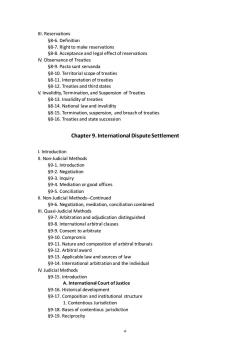
lll.Reservations 8-6.Definition Right to make reservations 58-8.Acceptance and legal effect of reservations IV.Observance of Treaties 58-9.Pacta sunt servanda $8-10.Territorial scope of treaties 8 treati 58-12.Treaties and third states V.Invalidity,Termination,and Suspension of Treaties $8-13.Invalidity of treaties 58-14.National law and invalidity Termination,suspension,and breach of treaties Chapter 9.International Dispute Settlement ll.Non-Judicial Methods 59-1.Introduction 59-2.Negotiation $9-3.Inquiry 59-4.Mediatior or good offices 59-5.Conciliation Il,Non-Judicial Methods-Continued 59-6.Negotiation,mediation,conciliation combined IIL Quasi-Judicial Methods 59-7.Arbitratio and adjudication distinguished 59-9.Consent to arbitrate $9-10.Compromis 59-11.Nature and composition of arbitral tribunals 59-12 Arbitral award 9-13.Applicable law and sources of law 59-14.International arbitration and the individual IV Judicial Methods 59-15.Introduction A.International Court of Justice 9-16.Historical devel 59-17.Composition and institutional structure 1.Contentious Jurisdiction $9-18.Bases of contentious jurisdiction 59-19.Reciprocity
vi III. Reservations §8-6. Definition §8-7. Right to make reservations §8-8. Acceptance and legal effect of reservations IV. Observance of Treaties §8-9. Pacta sunt servanda §8-10. Territorial scope of treaties §8-11. Interpretation of treaties §8-12. Treaties and third states V. Invalidity, Termination, and Suspension of Treaties §8-13. Invalidity of treaties §8-14. National law and invalidity §8-15. Termination, suspension, and breach of treaties §8-16. Treaties and state succession Chapter 9. International Dispute Settlement I. Introduction II. Non-Judicial Methods §9-1. Introduction §9-2. Negotiation §9-3. Inquiry §9-4. Mediation or good offices §9-5. Conciliation II. Non-Judicial Methods-Continued §9-6. Negotiation, mediation, conciliation combined III. Quasi-Judicial Methods §9-7. Arbitration and adjudication distinguished §9-8. International arbitral clauses §9-9. Consent to arbitrate §9-10. Compromis §9-11. Nature and composition of arbitral tribunals §9-12. Arbitral award §9-13. Applicable law and sources of law §9-14. International arbitration and the individual IV. Judicial Methods §9-15. Introduction A. International Court of Justice §9-16. Historical development §9-17. Composition and institutional structure 1. Contentious Jurisdiction §9-18. Bases of contentious jurisdiction §9-19. Reciprocity
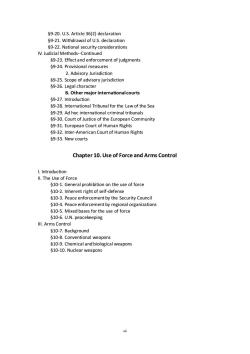
59-20.U.S.Article36(2)declaration $9-21.Withdrawal of U.S.declaration 5922 National securityco sideration IV.Judicial M Continued 59-23.Effect and enforcement of judgments $9-24.Provisional measures 2.Advisory Jurisdiction 59-25. Scope of advisory jurisdiction 59-26. ega B.Other major international courts $9-27.Introduction 59-28.International Tribunal for the Law of the Sea 59-31.European Court of Human Rights 59-32.Inter-American Court of Human Rights 59-33.New courts Chapter 10.Use of Force and Arms Contro I.Introduction Il.The Use of Force $10-1.General prohibition on the use of force 510-2.Inherent right of self-defense 510-3.Peace enforcement by the Security Council $10-4.Peace enforcement by regional organizations $10-5.Mixed bases for the use of force $10-6.U.N.peacekeeping .Arms Control $10-7.Background 610-8.Conventional weapons $10-9.Chemical and biological weapons $10-10.Nuclear weapons
vii §9-20. U.S. Article 36(2) declaration §9-21. Withdrawal of U.S. declaration §9-22. National security considerations IV. Judicial Methods-Continued §9-23. Effect and enforcement of judgments §9-24. Provisional measures 2. Advisory Jurisdiction §9-25. Scope of advisory jurisdiction §9-26. Legal character B. Other major international courts §9-27. Introduction §9-28. International Tribunal for the Law of the Sea §9-29. Ad hoc international criminal tribunals §9-30. Court of Justice of the European Community §9-31. European Court of Human Rights §9-32. Inter-American Court of Human Rights §9-33. New courts Chapter 10. Use of Force and Arms Control I. Introduction II. The Use of Force §10-1. General prohibition on the use of force §10-2. Inherent right of self-defense §10-3. Peace enforcement by the Security Council §10-4. Peace enforcement by regional organizations §10-5. Mixed bases for the use of force §10-6. U.N. peacekeeping III. Arms Control §10-7. Background §10-8. Conventional weapons §10-9. Chemical and biological weapons §10-10. Nuclear weapons
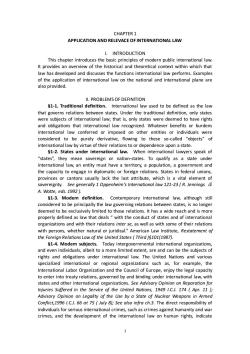
CHAPTER 1 APPLICATION AND RELEVACE OF INTERNATIONAL LAW I.INTRODUCTION This chapter introduces the basic principles of modern public international law. It provides an overview of the historical and theoretical context within which that law has developed and discusses the functions international law performs.Examples of the application of international law on the national and international plane are also provided II.PROBLEMS OF DEFINITION 61-1.Traditional definition.International law used to be defined as the law that gov ons betweer states nternational law;that is,only states were dee to have right and obligations that international law recognized.Whatever benefits or burdens international law conferred or imposed on other entities or individuals were considered to be purely derivative,flowing to these so-called "objects"of international law by e of thei ence a state p $1-2.States under international la w. When nternatio lawyers speak of "states",they mean sovereign or nation-states.To qualify as a state under international law,an entity must have a territory,a population,a government and the capacity to engage in diplomatic or foreign relations.States in federal unions, provinces or canton usually lack the last attribute,which is a vital element of ereignty. e generally 1Oppenheim's aw121-23(R.Jnnings A.Watte,eds.1992 ) 51-3.Modemn definition.Contemporary international law.although still considered to be principally the law governing relations between states,is no longer deemed to be exclusively limited to those relations.It has a wide reach and is more prope erly define as la tha deals with the duct of sta and of inte organizations and w th their relations inter se,as well as with some of their relations with persons,whether natural or juridical."American Law Institute,Restatement of the Foreign Relations Law of the United States(Third)$101(1987). $1-4.Modem subjects.Today intergovernmental international organizations and even individuals,albeit to a mo ore lim ted extent are nd can be the subjects of rights and e ational law.The United ons and variou specialized international or regional organizations such as,for example,the International Labor Organization and the Council of Europe,enjoy the legal capacity to enter into treaty relations.governed by and binding under international law.with states and other international c organizations.See Advisory Opinion on reparation for njuries Suffer ed in the S United ons .C1.174(Apr.11 Advisory Opinion on Legality of the Use by a State of Nuclear Weapons in Arme Conflict,1996 1.C.J.66 at 75 July 8);See also infra ch.3.The direct responsibility of individuals for serious international crimes,such as crimes against humanity and war crimes.and the development of the international law on human rights.indicate
1 CHAPTER 1 APPLICATION AND RELEVACE OF INTERNATIONAL LAW I. INTRODUCTION This chapter introduces the basic principles of modern public international law. It provides an overview of the historical and theoretical context within which that law has developed and discusses the functions international law performs. Examples of the application of international law on the national and international plane are also provided. II. PROBLEMS OF DEFINITION §1-1. Traditional definition. International law used to be defined as the law that governs relations between states. Under the traditional definition, only states were subjects of international law; that is, only states were deemed to have rights and obligations that international law recognized. Whatever benefits or burdens international law conferred or imposed on other entities or individuals were considered to be purely derivative, flowing to these so-called “objects” of international law by virtue of their relations to or dependence upon a state. §1-2. States under international law. When international lawyers speak of “states”, they mean sovereign or nation-states. To qualify as a state under international law, an entity must have a territory, a population, a government and the capacity to engage in diplomatic or foreign relations. States in federal unions, provinces or cantons usually lack the last attribute, which is a vital element of sovereignty. See generally 1 Oppenheim′s International law 121-23 ( R. Jennings & A. Watte, eds. 1992 ). §1-3. Modern definition. Contemporary international law, although still considered to be principally the law governing relations between states, is no longer deemed to be exclusively limited to those relations. It has a wide reach and is more properly defined as law that deals “ with the conduct of states and of international organizations and with their relations inter se, as well as with some of their relations with persons, whether natural or juridical.” American Law Institute, Restatement of the Foreign Relations Law of the United States ( Third )§101(1987). §1-4. Modern subjects. Today intergovernmental international organizations, and even individuals, albeit to a more limited extent, are and can be the subjects of rights and obligations under international law. The United Nations and various specialized international or regional organizations such as, for example, the International Labor Organization and the Council of Europe, enjoy the legal capacity to enter into treaty relations, governed by and binding under international law, with states and other international organizations. See Advisory Opinion on Reparation for Injuries Suffered in the Service of the United Nations, 1949 I.C.J. 174 ( Apr. 11 ); Advisory Opinion on Legality of the Use by a State of Nuclear Weapons in Armed Conflict,1996 I.C.J. 66 at 75 ( July 8); See also infra ch.3. The direct responsibility of individuals for serious international crimes, such as crimes against humanity and war crimes, and the development of the international law on human rights, indicate
按次数下载不扣除下载券;
注册用户24小时内重复下载只扣除一次;
顺序:VIP每日次数-->可用次数-->下载券;
- 新疆大学:《国际法》课程授课教案(中文版).doc
- 《行政法》课程实验教学案例资料.doc
- 《行政法》课程教学资源(试卷习题)行政法与行政诉讼法自考历年真题(部分带答案).doc
- 重庆警察学院:《行政法》课程教学课件(PPT讲稿)第二章 行政法主体论、公务员.pptx
- 重庆警察学院:《行政法》课程教学课件(PPT讲稿)第一章 行政法基础理论.pptx
- 重庆警察学院:《行政法》课程教学课件(PPT讲稿)第五章 行政程序法.pptx
- 重庆警察学院:《行政法》课程教学课件(PPT讲稿)第四章 行政行为 第三节 具体行政行为.pptx
- 重庆警察学院:《行政法》课程教学课件(PPT讲稿)第四章 行政行为 第二节 抽象行政行为.pptx
- 重庆警察学院:《行政法》课程教学课件(PPT讲稿)第四章 行政行为 第一节 行政行为概述.pptx
- 重庆警察学院:《行政法》课程教学课件(PPT讲稿)第七章 行政补偿.pptx
- 重庆警察学院:《行政法》课程教学课件(PPT讲稿)第六章 行政赔偿.pptx
- 重庆警察学院:《行政法》课程教学课件(PPT讲稿)第三章 行政职权.pptx
- 重庆警察学院:《行政法》课程教学课件(PPT讲稿)第八章 行政复议.pptx
- 《行政法》课程教学资源(讲义)行政法与行政诉讼法(共二十二章).doc
- 重庆警察学院:《行政法》课程授课教案(共八章).docx
- 重庆警察学院:《行政法》课程教学大纲(本科,负责人:孟令战).docx
- 《民法》课程PPT教学课件(物权法)第7章 占有.ppt
- 《民法》课程PPT教学课件(物权法)第6章 担保物权.ppt
- 《民法》课程PPT教学课件(物权法)第5章 用益物权.ppt
- 《民法》课程PPT教学课件(物权法)第4章 所有权的特殊问题.ppt
- 新疆大学:《国际法》课程经典教学案例.doc
- 新疆大学:《国际法》课程习题与答案.doc
- 新疆大学:《国际法》课程知识结构图.pdf
- 中国人民大学:《国际法》课程教学课件(PPT讲稿)第一章 导 论.ppt
- 中国人民大学:《国际法》课程教学课件(PPT讲稿)第二章 国际法的基本原则.ppt
- 中国人民大学:《国际法》课程教学课件(PPT讲稿)第三章 国际法上的国家.ppt
- 中国人民大学:《国际法》课程教学课件(PPT讲稿)第四章 国际法上的个人.ppt
- 中国人民大学:《国际法》课程教学课件(PPT讲稿)第五章 国际人权法.ppt
- 中国人民大学:《国际法》课程教学课件(PPT讲稿)第六章 国家领土.ppt
- 中国人民大学:《国际法》课程教学课件(PPT讲稿)第七章 海洋法.ppt
- 中国人民大学:《国际法》课程教学课件(PPT讲稿)第八章 空间法.ppt
- 中国人民大学:《国际法》课程教学课件(PPT讲稿)第九章 外交和领事关系法.ppt
- 中国人民大学:《国际法》课程教学课件(PPT讲稿)第十章 条约法.ppt
- 中国人民大学:《国际法》课程教学课件(PPT讲稿)第十一章 国际组织法.ppt
- 中国人民大学:《国际法》课程教学课件(PPT讲稿)第十二章 国家责任法.ppt
- 中国人民大学:《国际法》课程教学课件(PPT讲稿)第十三章 和平解决国际争端.ppt
- 中国人民大学:《国际法》课程教学课件(PPT讲稿)第十四章 武装冲突法.ppt
- 《经济法》课程教学资源(试卷习题,含参考答案)第一章 经济法的产生和发展.doc
- 《经济法》课程教学资源(试卷习题,含参考答案)第二章 经济法的概念.doc
- 《经济法》课程教学资源(试卷习题,含参考答案)第三章 经济法的地位和体系.doc
